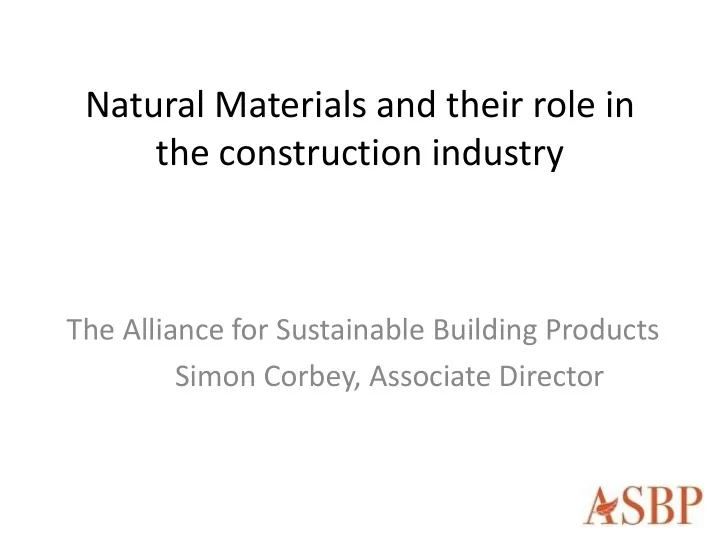

Natural Materials and their role in the construction industry The Alliance for Sustainable Building Products Simon Corbey, Associate Director
Mission driven organisation To accelerate the transformation to a sustainable built environment and society, by championing the understanding and use of demonstrably sustainable building products .
Which means the ASBP are… Promoting a products and materials agenda so that consideration of their performance and impacts is embedded in policy and becomes an essential cornerstone of good design. Encouraging a step change in the development, understanding, identification, specification and use of sustainable building products. Promoting new business models and approaches to ensure that product and material sustainability is optimised and delivered in reality.
Founder Members
Standard Members
The ASBP big themes Sustainable Products Resource Efficiency HEALTH RISK LOCAL LOW CARBON REPLACE DURABILITY Mainstream Step change
What is carbon sequestration? • Growing trees absorb CO 2 and sequester (store) it in their trunks, branches, roots and leaves • Half a tree’s weight is water. Half of the rest is CARBON
Other natural materials Material Carbon Content (%) Carbon dioxide equivalent (kgCO 2e /kg) Hemp 46 1.68 Straw 40 1.46 Recycled paper 43 1.57 Sheep wool 42 1.53 Murphy, R.J. & Norton, A. (2008) Life Cycle Assessments of Natural Fibre Insulation Materials. York: National Non-food Crops Centre. Powlson, D.S., Riche, A.B., Coleman, K., Glendining, M.J. & Whitmore, A.P. (2008) 'Carbon sequestration in European soils through straw incorporation: limitations and alternatives', Waste Management, 28 (4), pp.741-746. Micales, J.A. & Skog, K.E. (1997) ' The decomposition of forest products in landfills', International Biodeterioration and Biodegradation, 39 (2), pp.145-158.
Sequestered carbon in products Fossil fuel displacement benefit recognised in biomass energy policy Carbon sequestration benefit recognised in forestry In contrast no benefit is currently recognised for the carbon sequestered in products
Product level Green Guide to Specification The BRE methodology by taking snap shot view (160) years after product installed assumed all carbon released Furthermore – no benefit allocated to energy recovery (double counting) Decay assumptions pessimistic, wrong and different to IPCC
Kyoto Protocol Kyoto Protocol Carbon stored in new forests (since 1990) included in national greenhouse gas inventory Durban (February 2012) Carbon stored in harvested wood products (HWP) now included in national greenhouse gas inventory
Independent Panel on Forestry Recommendation ‘ Government should establish a single recognised methodology to account for the full greenhouse gas benefits of using wood and timber products and permit its use as part of carbon accounting. Clear guidance should encourage the use of wood as a sustainable construction and manufacturing material .’
Business as usual – a missed opportunity The annual additional increment of carbon in harvested wood products in building is expected to rise from about 8 MtCO 2 /year in 2005 to 14 MtCO 2 /year by 2050 Image: UNECE Ref. Sadler and Robson (2011)
Supportive policy – a climate change mitigation strategy The potential effects of policies designed to encourage increased use of all biogenic materials (wood, hemp, straw, wool etc.) in all UK buildings suggest that the carbon sequestration could be as high as: Image: Aarmourtherm Foundation 10 MtCO 2 /year by 2020 and 22 MtCO 2 /year by 2050
33 MtCO 2e Embodied carbon emissions from UK construction (2010) Ref. Green Construction Board Roadmap
Climate targets and economic growth ‘Low intervention’ 1 Increase in UK forest processing industry worth £10 billion (NPV up to 2030) Increased ‘green’ jobs by 7,000 by 2030 Increased carbon store by 19 MtCO 2e (gross UK timber) Increased forest area under management by 385,000 ha by 2030 Ref 1: Figures based upon current work by RES For DEFRA Developing an evidence base for furthering the use of English wood products in a range of markets.
Policy opportunities Product Level (BREEAM and CfSH) Fair, consistent and transparent assessment methods Allow benefit for temporary carbon storage (weighted average or IPCC half lives). Not current snap- shot view
Policy opportunities Ban wood to landfill Remove uncertainty of GHG release from wood in landfill, encourage re- use and recycling and provide more raw material for industry
Policy opportunities Project Level Embodied carbon reduction (sequestered carbon) considered as an ‘allowable solution’
Policy opportunities Embodied impact targets (CO 2e /m 2 /yr) The green construction board of 65% reduction in capital carbon. Heavily dependent on decarbonised grid and CCS
Sir Alec Reed Academy
Sir Alec Reed Academy
Sir Alec Reed Academy • BREEAM very good • 1073m3 CLT • Embodied energy 217tCO2e • Sequestered carbon=negative impact • Reduced GLA 20% renewables target to 10% • Saved £150k on PVs •
Conclusions Permanent store of biogenic carbon is a climate change mitigation opportunity Currently assessment methodologies are inconsistent and discourage more sustainable biogenic products and materials Encouraging production and use of biogenic material is an economic growth opportunity
More about ASBP • Please contact me; • Simon Corbey • simon@asbp.org.uk • Inverness 18 th March • April 9 th Debate: Embodied carbon should be included in 2019 Zero Carbon Definitions; UCL • www.asbp.org.uk
Recommend
More recommend